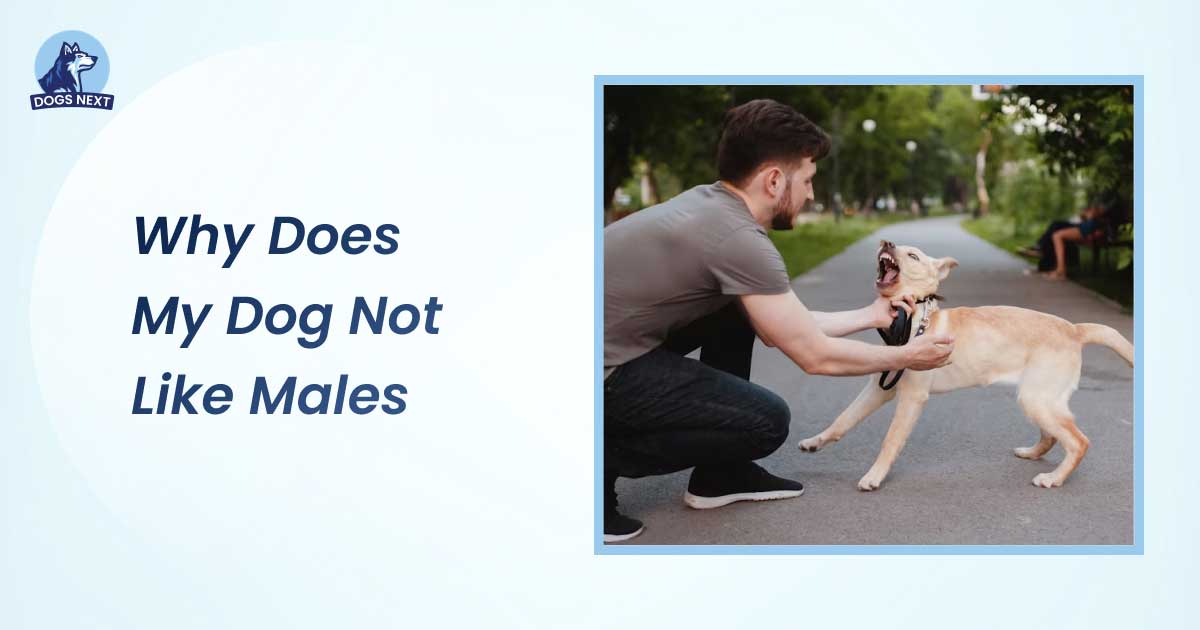Your dog might not like males due to past negative experiences or a lack of socialization with men. Dogs can also sense fear or discomfort in people.
Dogs have unique personalities and experiences that shape their behavior. Some dogs may develop aversions to specific genders based on past encounters. For example, if a male mistreated a dog, it might associate all men with that negative experience. Socialization plays a crucial role in a dog’s reactions.
If a dog wasn’t exposed to many males during its formative years, it might feel uneasy around them. Observing your dog’s body language and reactions can provide clues. Consulting a professional dog trainer or behaviorist can help address and improve this issue, ensuring a more harmonious relationship between your dog and the males it encounters.
Common Reasons Dogs May Dislike Males
Have you ever wondered, “Why does my dog not like males?” This behavior can be perplexing and concerning for many dog owners. Understanding the common reasons behind this aversion can help you address the issue effectively. Let’s dive into the various factors that might cause your dog to dislike males.
Past Trauma Or Negative Experiences
Dogs can develop aversions to males due to past trauma or negative experiences. These experiences can deeply impact their perception and behavior towards men. Some common causes include:
- Abuse by a male figure: If a male mistreated your dog in the past, the dog might associate males with pain or fear.
- Lack of socialization: Dogs that haven’t been exposed to males during their critical socialization period may find them unfamiliar and intimidating.
- Loud voices or sudden movements: Men generally have deeper voices and might make sudden movements, which can startle or scare a dog.
Understanding these triggers can help you create a safer environment for your dog. Try to identify specific actions or situations that seem to upset your dog. Here is a table summarizing some common triggers:
| Trigger | Possible Cause |
|---|---|
| Loud voice | Startling the dog |
| Sudden movements | Fear response |
| Physical approach | Past abuse |
Working with a professional dog trainer or behaviorist can be beneficial. They can help desensitize your dog to these triggers and build positive associations with males.
Past Trauma Or Negative Experiences
Repeated negative encounters with males can reinforce a dog’s fear or dislike. Understanding the specific events that contributed to this behavior is crucial. Here are some scenarios where negative experiences can occur:
- Veterinary visits: If male vets or staff handled your dog roughly, it might develop a fear of males.
- Dog parks: Encounters with aggressive male dogs or male owners can leave a lasting impact.
- Home environment: Witnessing arguments or loud interactions involving males can be distressing for a dog.
Identifying the exact cause can be challenging, but observing your dog’s reactions can offer clues. Look for signs of distress such as:
- Cowering or hiding
- Growling or barking
- Trembling or shaking
Creating positive experiences with males can help mitigate this aversion. Here are some steps to take:
- Gradual exposure: Introduce your dog to calm and gentle males in controlled settings.
- Positive reinforcement: Reward your dog with treats and praise for calm behavior around males.
- Patience and consistency: Building trust takes time, so be patient and consistent in your efforts.
Remember, every dog is unique, and what works for one may not work for another. Tailoring your approach to your dog’s specific needs and history can lead to better outcomes.
Behavioral Signs That Indicate Your Dog Dislikes Males
Have you ever noticed your dog behaving differently around men? Some dogs show clear signs of discomfort or even aggression toward males. Understanding these behavioral signs can help you address the issue and make your dog feel more comfortable. This section covers the key behavioral signs indicating your dog dislikes males.
How To Recognize Fearful Or Aggressive Behavior Toward Men
Dogs often show fearful or aggressive behavior around men in various ways. Recognizing these signs is the first step to understanding your dog’s discomfort.
- Tucking Tail: A clear sign of fear is when a dog tucks its tail between its legs.
- Ears Back: Dogs often pin their ears back when they feel threatened.
- Growling or Barking: Aggressive growling or barking directed at men is a common sign.
- Avoidance: If your dog actively avoids men, this is a strong indicator of discomfort.
- Shaking: Shaking or trembling is another sign of fear.
- Raised Hackles: The fur along the back standing up indicates aggression or fear.
| Behavior | Indication |
|---|---|
| Tucking Tail | Fear |
| Growling/Barking | Aggression |
| Avoidance | Discomfort |
| Shaking | Fear |
Recognizing these behaviors helps you understand that your dog may not be comfortable around men. Pay close attention to these signs to take appropriate action.
What Triggers Your Dog’s Reaction?
Understanding what triggers your dog’s reaction to males is crucial. Several factors can influence your dog’s behavior.
- Past Trauma: Negative experiences with men can lead to lasting fear or aggression.
- Lack of Socialization: Dogs not exposed to men early may react fearfully.
- Body Language: Men’s larger stature and deeper voice can be intimidating to dogs.
- Smell: Dogs have a strong sense of smell and may react to unfamiliar scents.
- Behavior of Men: Sudden movements or loud voices from men can startle dogs.
| Trigger | Impact |
|---|---|
| Past Trauma | Fear/Aggression |
| Lack of Socialization | Fear |
| Body Language | Intimidation |
| Smell | Discomfort |
| Behavior of Men | Startle Response |
Identifying these triggers helps you address the root cause of your dog’s discomfort. Understanding the source of fear or aggression will guide you in helping your dog overcome these reactions.
Addressing And Overcoming A Dog’s Dislike Of Men
Dogs sometimes show a fear or dislike of men due to past experiences, lack of socialization, or genetic factors. Addressing and overcoming a dog’s dislike of men involves understanding the root cause and using consistent training techniques. Patience and positive reinforcement can help a dog feel safe around men.
Training Techniques To Help Socialize Your Dog
Socializing your dog with men can reduce fear and aggression. Here are some effective training techniques:
- Gradual Exposure: Introduce your dog to men slowly and in a controlled environment.
- Desensitization: Start from a distance and slowly reduce the space as your dog becomes more comfortable.
- Controlled Interactions: Ensure that the men interacting with your dog are calm and patient.
Using a table can help track your dog’s progress:
| Day | Activity | Dog’s Reaction |
|---|---|---|
| 1 | Man walks by at a distance | Calm |
| 2 | Man stands closer, no interaction | Alert but not aggressive |
| 3 | Man offers treats | Accepts treat |
Regular socialization is key. Plan daily sessions and slowly increase the duration. Patience and consistency are crucial for success.
Using Positive Reinforcement To Create Positive Associations
Positive reinforcement can help create positive associations with men. Here are some strategies:
- Reward Good Behavior: When your dog remains calm around men, offer treats or praise.
- Use Favorite Toys: Allow men to play with your dog’s favorite toys to build trust.
- Keep Sessions Short: Short, frequent sessions are more effective than long, stressful ones.
Consider this sample reinforcement schedule:
| Day | Activity | Reward |
|---|---|---|
| 1 | Man offers treat | Favorite snack |
| 2 | Man plays with toy | Extra playtime |
| 3 | Man pets dog | Praise and treat |
Consistency and repetition are essential. Over time, your dog will associate men with positive experiences, reducing fear and anxiety.
When Dislike Turns To Aggression
Dogs have unique personalities, and sometimes they develop unusual preferences or dislikes. If your dog shows a particular aversion to males, it could be due to past experiences or lack of socialization. When this dislike turns to aggression, it becomes a serious issue that needs immediate attention. Aggressive behavior can lead to dangerous situations, making it crucial to address the problem swiftly and effectively.
Working With A Dog Trainer Or Behaviorist
Seeking the help of a professional dog trainer or behaviorist is the best course of action. These experts have the skills to identify triggers and develop a customized plan to manage and reduce aggression.
Here are some benefits of working with a professional:
- Personalized Training Plans: Each dog is unique, and a trainer can create a plan tailored to your dog’s needs.
- Expertise in Behavior Modification: Trainers understand the root causes of aggression and how to address them.
- Safety Protocols: They implement techniques to ensure the safety of both the dog and owner during training.
Common techniques used include:
- Desensitization: Gradually exposing the dog to males in a controlled manner to reduce fear and aggression.
- Counter-Conditioning: Associating males with positive experiences, like treats or playtime, to change the dog’s perception.
- Obedience Training: Reinforcing basic commands to improve overall behavior and control.
Understanding the process can be simplified with this table:TechniqueDescriptionDesensitizationGradual exposure to malesCounter-ConditioningAssociating males with positive experiencesObedience TrainingBasic command reinforcement
Working with a professional ensures that the training is effective and humane. It also provides you with the knowledge to manage your dog’s behavior in the long term. Always choose a certified trainer or behaviorist who uses positive reinforcement techniques.
Frequently Asked Questions
Why Is My Dog Afraid Of Men?
Dogs may fear men due to past negative experiences. Men often have deeper voices and larger builds, which can be intimidating. Early socialization plays a crucial role.
Can Dogs Sense Male Aggression?
Yes, dogs can sense aggression through body language and tone of voice. They may react fearfully to perceived threats, including male aggression.
How Can I Help My Dog Like Men?
Gradual exposure to kind, calm men can help. Positive reinforcement and patience are key. Reward your dog for calm behavior around men.
Do Male Hormones Affect Dogs’ Behavior?
Yes, dogs can detect hormonal differences. Testosterone in men may make them seem more intimidating to some dogs, affecting their behavior.
Conclusion
Understanding why your dog dislikes males can improve their well-being. Address their fears with patience and positive reinforcement. Seek professional help if needed. Every dog is unique, and with care, they can overcome their anxieties. Building trust takes time, but it’s worth the effort for a happier pet.

I’m David, an expert contributor and writer, with two furry friends of my own, I know the challenges of raising and caring for dogs. From training to nutrition and health, my goal is to provide valuable insights and advice to help create strong bonds and happy, healthy lives. Find me in Twitter.




